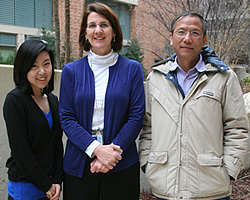
Endocrine Section (From left to right)
Renee Choi, Julia Arnold, Xunxian Liu
Acting Chief: Robert B. Nussenblatt, M.D.
Endocrine Section
Contact Information
National Center for Complementary and Alternative Medicine,
Laboratory of Clinical Investigation
Endocrine Section Intramural Laboratory
NCCAM/NIH
Building 10, Room 2B47
10 Center Drive , MSC 1547
Bethesda, MD 20892-1547
Phone: 301-435-6760
Fax: 301-480-3159
E-mail: nussenblattr@mail.nih.gov
Current Research
The Endocrinology Section conducts laboratory-based investigations defining the effects of endocrine-related complementary and alternative medicine (CAM) agents on normal and neoplastic human prostate stromal and epithelial cells by characterizing endocrine-immune-paracrine interactions in normal vs. cancerous tissue microenvironments.
The goal of this research is twofold. The first objective is a basic biological approach to define hormonal–responsive paracrine signaling mechanisms involved in interactions between human prostate normal and cancer stromal and epithelial cells. We have specifically focused on the effects of the over–the–counter CAM supplement, dehydroepiandrosterone (DHEA) in the prostate and its effects on prostate epithelial cells as mediated by stromal cells. These studies include identification and characterization of DHEA–induced paracrine growth and inhibitory factors; elaborating endogenous and exogenous factors affecting steroid metabolizing enzymes in both stromal and epithelial cells; and defining the role of chemokines and cytokines (TGFβ) in the intracrine metabolism of DHEA. Other studies are investigating effects of DHEA and its metabolites, dihydrotestosterone, 5a-Androstane-3β, 17β-Diol (3β-Adiol) or Estradiol (E2), on β-catenin/TCF signalling (β-CTS) in androgen receptor non-responsive prostate DU145 or PC3 cancer cells as mediated by estrogen receptor (ER)β, Gαo or GPR30 another a G-protein coupled ER.
The second laboratory objective is a translational approach to use this in vitro reproduction of endocrine (DHEA), immune (TGFβ) and paracrine (stromal) interactions to test a variety of herbal-botanical agents that may target the signals modulating the response between stromal and epithelial cells. To this end we have investigated effects of lycopene and red clover isoflavones in proof-of-concept studies. This integrative approach is important in the field of study of traditional and herbal medicines as the effects of these agents are likely multifocal, containing many active ingredients that target tissues/physiology through multiple mechanisms. The development of such protocols is vital to forge the frontier of discovery in safety and efficacy of complementary and alternative medicines for human use.
